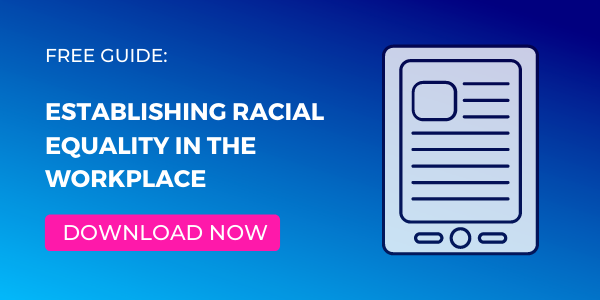Recently there has been a much-needed surge of activism and call for systemic change against racism and oppression in the U.S. These events have set a much higher standard for how companies handle diversity, equity and inclusion (DEI).
DEI should be part of a company’s DNA. It needs to be learned, talked about and acted upon all of the time, for the rest of time. It is no longer a topic companies can just discuss, they must take action.
As a leader, you must take ownership in enacting necessary change within your organization to build a workplace free of racism and oppression. However, that’s easier said than done.
We spoke with two DEI leaders, Anna Chalon, Director of Recruiting and D&I at Frame.io and Lauryn Nwankpa, Head of Social Impact at Dave, to learn how companies can remove racism and oppression from their own organizations.
A guide to supporting the development of rising women in tech.
4 Strategies to Invest in Now
#1: Inclusion
A successful DEI strategy starts with inclusivity before anything else. Building an inclusive workplace allows for and encourages each employee to be their most authentic selves, and ensures individuals feel welcomed, connected and valued at work.
Without this foundational strategy in place first, your diversity and equity efforts will suffer.
Nwankpa echoes this sentiment saying, “Getting diverse talent through the door is just half of the battle. Companies need to focus on creating an environment that makes people feel heard, welcomed and appreciated every day — especially during times like the ones we’re in now.”
#2: DEI Recruitment
After you’ve built an inclusive culture, you can then begin building recruitment strategies that are centered around DEI. Chalon offered a few suggestions on how companies can do this:
Inclusive Job Descriptions
Traditional job descriptions often use language and have requirements that can promote biases. Companies need to audit their own job descriptions to remove bias and be more inclusive during the hiring process. Some examples of what companies should watch out for in job descriptions are gendered terms like “ninja” or “rockstar” and including college education requirements that aren’t actually needed.
Diverse Interview Panels
If you’re building a truly diverse, equitable and inclusive work environment, that needs to be reflected in everything that you do, especially during the hiring process. If you’ve succeeded in getting a diverse candidate to apply for your role but have an all white male interview panel, you will likely push the candidate away. You must be thoughtful about who is part of your interview process.
Culture Add Instead of Fit
People tend to like those who are similar to them and because of this companies end up having a workforce that looks and thinks alike. When choosing the best candidates for your organization, you must embrace the idea of culture add, not fit. This means finding the individuals who not only share in your company’s values and mission, but enhance the overall employee experience.
DEI Interview Questions
During the recruitment process, you must assess whether or not potential employees would add to a culture that is centered around DEI. Here are a few questions you can ask candidates during the interview process to do just that:
- [All Candidates] What does diversity mean to you?
- [Manager & Above] What are the top three traits you look for in candidates?
- [Manager & Above] Do you hire more for tangible skills or for potential? A mix of both?
- [Manager & Above] What have you done in the past to ensure that you are building a diverse and inclusive team? What have you learned along the way?

#3: Transparent Culture
Developing DEI groups internally to share experiences fosters empathy and transparency across your organization. As leaders, you need to support speaking up and speaking out within your workplace. You need to build a culture that embraces being uncomfortable and having tough conversations.
Nwankpa says it’s critical that employees feel seen and heard at work. Companies must emphasize and commit to making space for having intentional, tough conversations about race, gender identity and systems of inequity. Having these conversations in a way that cherishes the lived experiences and perspectives of all employees is a step in the right direction. Showing up authentically will help create space for others in your workplace to do the same.
To be successful in having these conversations and creating a transparent culture, Chalon says leaders need to educate themselves by reading, asking questions and moving past the defensiveness that can happen during this process. Learn to deal with the uncomfortable because that likely means you’re heading in the right direction.
#4: A Company-Wide Approach
Many companies put the responsibility of DEI on HR teams, but Chalon offers insight as to whether or not that was the best approach. She says, “I think it’s good for HR to be leading some of these initiatives but I still think it needs to start at the top.” Leadership buy-in is key; without it, HR will struggle to actually make progress in their DEI efforts.
Some companies also hire a Chief Diversity Officer to own these efforts internally. Chalon feels this is a step in the right direction, but it doesn’t solve all of a company’s diversity issues. She recommends auditing your company’s current culture so you can identify the areas that need change and ensure these changes don’t happen in a vacuum.
Chalon also recommends developing a diversity and inclusion committee or core team to lead employee-driven initiatives. This helps infuse your DEI strategy across the whole company, not just in your HR department.
Nwankpa shares insights into how they embrace this mindset at Dave saying, “We ground our equity and inclusion work in our broader social impact strategy to ensure our progress is comprehensive, sustainable and mission aligned.” She continues by saying, “This allows for broader access to resources, collaboration and budget.”
Enacting change within your workplace isn’t easy. It takes time and a commitment to investing in long-term change. Use the advice from these leaders as a starting point for building a successful DEI strategy throughout your entire organization. Investing in this much-needed change will make your organization more supportive and inclusive of your current employees and your employees of the future.
How to create core values that will inspire your workforce.




